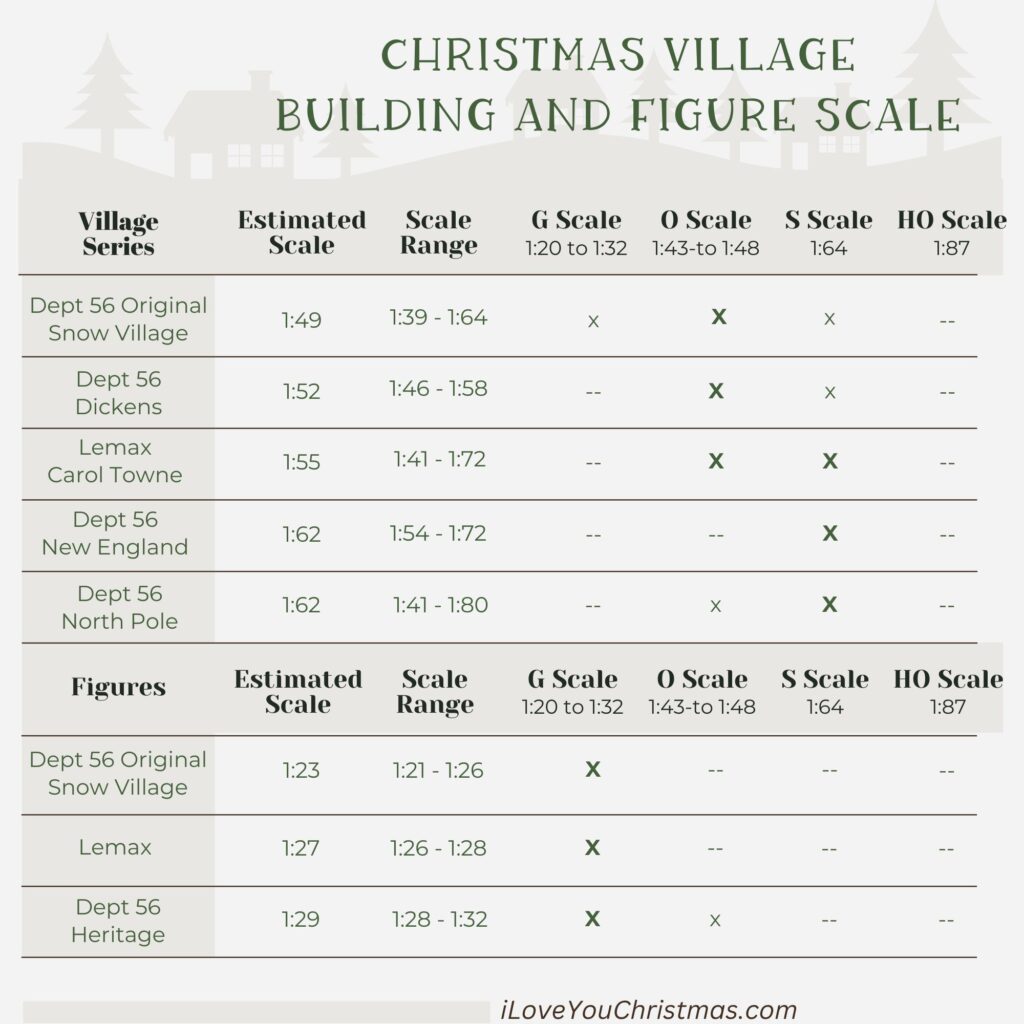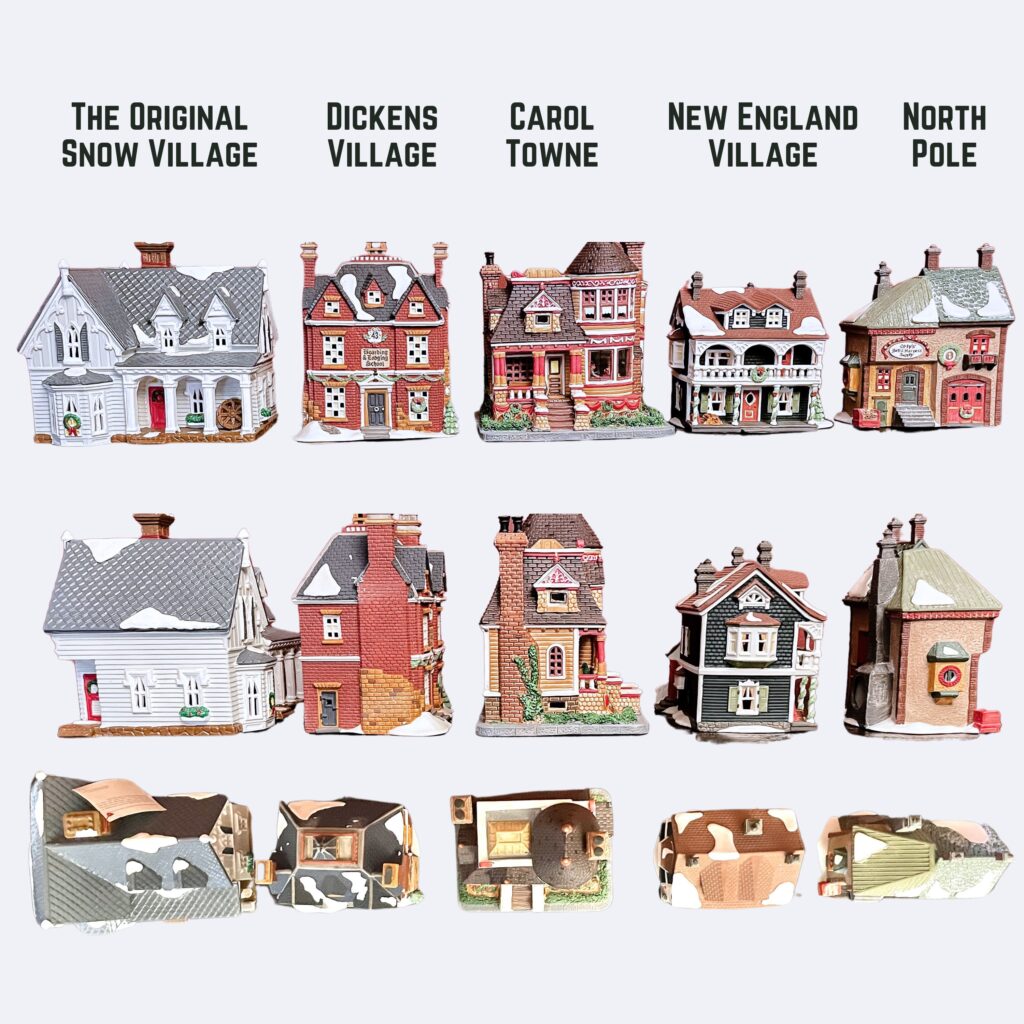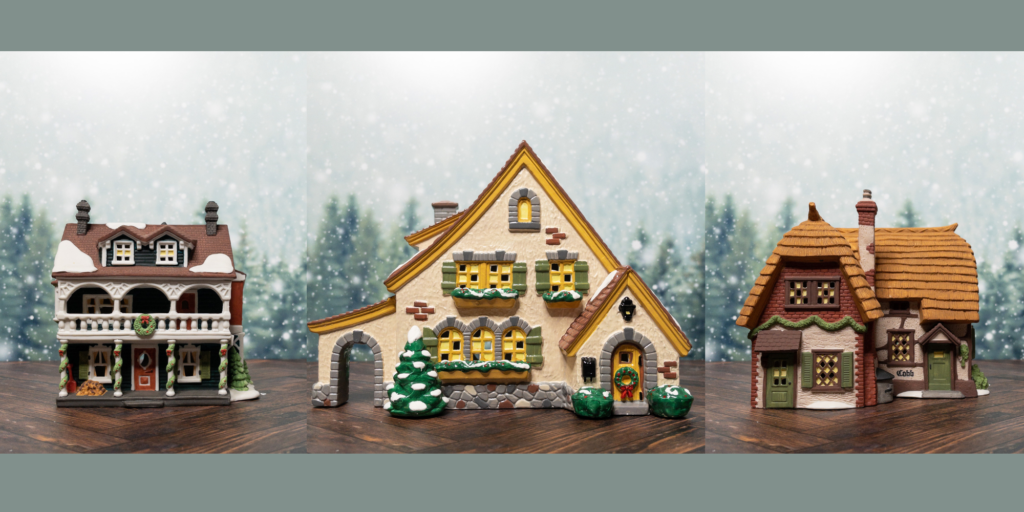From the moment you set up your first Christmas Village, you understand the importance of scale. The magic of a Christmas village is born from staring into its twinkly lights and imagining what the holiday season is like in that perfect Christmas town. Consistency in the scale of your Christmas Village buildings and figures is key to creating a display that truly sparks the imagination.
In this post, I am going to answer the question of Christmas Village Scale. Starting with understanding scale and how I calculated it. Then I will share with you the estimated scale sizes I calculated for as many Christmas Village Brands I could get my hands on.
Scale data for the following villages series will be shared in the table linked below:
- Dept 56 The Orginal Snow Village
- Dept 56 Dickens Village
- Lemax Carol Towne
- Department 56 New England Series
- Department 56 North Pole
The Connection Between Christmas Villages and Model Trains
Christmas villages and model train layouts often go hand in hand, creating enchanting winter wonderlands. Picking Christmas village pieces and model trains with similar scales is crucial for a cohesive, realistic, and harmonious display.
While there is no standard scale for Christmas Villages, model trains are available in standardized scales.
Model Train Scales
The most widely used model train scales for Christmas displays include:
- G Scale (1:20-1:32): Known as Large Scale or Garden Scale, this is the largest size for model trains. Their durability makes them an ideal choice for families and a favorite for display under the Christmas tree.
- O Scale (1:43-1:48): Larger and more detailed, their size allows for greater detail in models and accessories, making them a striking addition to holiday displays. O-scale trains are often associated with traditional Christmas train sets circling the tree.
- S Scale (1:64): S scale trains are a popular choice for those who want a good balance between size and detail. Noticeably larger, offering more intricate detailing on locomotives and rolling stock.
- HO Scale (1:87): This is the most popular scale for model trains, it offers a wide variety of accessories and scenery.
- N Scale (1:160): Smaller than HO, N-scale trains can be quite detailed, allowing for intricate layouts in a compact area. They’re perfect for creating mini winter wonderlands.
So how do we know which Christmas Villages work with which Model Train scale?
That’s what I set out to answer. AND I DID!
But first, we need to understand scale and how I calculated it for Christmas Villages.
What is Scale and How to Calculate It?
What Is Scale?
Scale refers to the relative size of the miniature items to their real-life counterparts. For example, model trains or Village Buildings. This scale determines how small the model train or building is compared to the actual train or building it represents.
SCALE is typically expressed as a ratio, such as 1:12 or 1:48, where the first number represents one unit of measurement on the miniature item, and the second number represents the equivalent number of units on the real-life counterpart
For example, on a 1:48 scale, a one-inch figure of a child would be equivalent to a 48-inch (or 4-foot-tall) child in real life.
How To Calculate Scale?
Calculating the scale of an object is relatively straightforward. You’ll need a measuring tape and some patience:
- Measure the height of the miniature object.
- Measure the height of the corresponding real-world object in the same unit of measurement (i.e. inches).
- Divide the height of the real-world object by the height of the miniature.
- Take the reciprocal of that number to get the scale
FOR EXAMPLE: If the real-world building it represents is 96 inches tall, and your miniature building is 3 inches tall (96 ÷ 3 = 32). The scale would be 1/32 or 1:32
The 1:32 scale in Christmas Village Buildings means that every 1-inch height of the Village building corresponds to 32 inches of height on an actual building.
Calculating Scale For Christmas Villages and Figures
As I mentioned before, keeping the same scale for your buildings, figures, and trains can really help bring your village to life. Knowing the scale for different Christmas Village buildings and figures, allows you to mix and match buildings, figures, and trains all with a similar proportion. This way, everything fits together perfectly, making your holiday setup look realistic and cohesive.
So with that, let’s get into how I calculated the scale for Christmas Village Buildings and Figures
Calculating Scale for Christmas Village Buildings
When calculating the scale for the village buildings, I needed to use something consistent across different brands and styles. I used a technique where you measure a known feature on a building (like a door or window) and then compare it to the real-life measurement. You then take the ratio of those two measurements to determine the scale factor.
I opted to focus on measurements of 2 known features that I felt would stay consistent across brands and styles, the height of the exterior doors and the height of a floor.
- Door Height – measured the height of all the doors and took an average.
- Floor Height – measured from the floor of the building to roof eves then divided by # of floors to calculate the average floor height.
Steps For Calculating Village Building Scale
STEP 1: GATHER THE VILLAGE BUILDINGS TO BE USED TO ESTIMATE THE SCALE
I picked 10 buildings within a village series; a mixture of houses, churches, schools, and commercial buildings.
STEP 2: TAKE MEASUREMENTS OF THE VILLAGE BUILDINGS
I measured and recorded
- VILLAGE BUILDING DOOR HEIGHT: the Door height of all exterior doors on the village building and took the average
- VILLAGE BUILDING FLOOR HEIGHT: the height from the floor of the building to the eve of the house and divided by the number of stories
STEP 3: DETERMINE THE REAL-WORLD BUILDING MEASUREMENTS
For real-world building measurements, I used
- REAL WORLD BUILDING DOOR HEIGHT: The standard exterior door height is 80 inches, so this is the measurement I used for real-world building door height.
- REAL WORLD BUILDING FLOOR HEIGHT: The average floor-to-ceiling height is 9 feet or 108 inches. So this is the measurement I used for real-world building floor height.
STEP 4: CALCULATE VILLAGE BUILDING SCALE
I calculated the Door Height Scale Factor and the Floor Height Scale Factor then took an average of both these to determine VILLAGE BUILDING SCALE.
- Calculate Door Height Scale Factor = (80 / Village Building Door Height) for each building
- Calculate Floor Height Scale Factor = (96 / Village Building Floor Height ) for each building
- Take the average of those numbers –> Christmas Village Scale Factor
- Convert that to 1/Christmas Village Scale Factor
- The result is VILLAGE BUILDING SCALE
Steps For Calculating Village Figures
Calculating the scale for Christmas Villages FIgures is more straightforward.
STEP 1: GATHER THE FIGURES TO BE USED TO ESTIMATE THE SCALE
I focused on calculating scale using adult figures and I chose figures that were standing upright to get the most accurate measure of height.
STEP 2: MEASURE THE FIGURES
Measure and record men’s and women’s heights separately.
STEP 3: DETERMINE THE REAL-WORLD MEASUREMENTS
For adult’s average height, I used 69 inches for Men ( 5’9″)and 64 inches for Women ( 5’4″).
STEP 4: Calculate Figure Scale
- calculate Men’s Height Scale Factor = (69 / Men’s Height) for each male figure
- calculate Woman’s Height Scale Factor = (64 / Woman’s Height ) for each female figure
- Take the average of those numbers –> Figure Scale Factor
- convert that to 1/Figure Scale Factor
- The result is VILLAGE FIGURE SCALE
Christmas Village Scale Table

Table Glossary
This table includes the iLoveYouChristmas calculated scale and the corresponding train scales they would work best with so you can create a Christmas Village Display.
The table includes:
- the iLoveYouChristmas Calculated Scale. Click here to see how that was calculated.
- the Range of this calculated scale. The high and low of the calculated scales.
- X indicates what train scale each series works best with, x indicates other potential scales it can work with.
Detailed Information About Each Village Series

4 of the 5 Villages I estimated scale for are from Department 56. And that doesn’t even scratch the surface of what they offer. If you want to know how many Department 56 Villages there are and how they differ. Check out this Blog post.
Department 56 The Orginal Snow Village – Scale 1:49
- This Village has a GLOSSY finish. It’s the only series we’ve calculated a scale for that features this glossy detail.
- The Calculated Scale is 1:49, with a range of 1:39-1:64.
- This village series is the biggest of all the series I calculated. It also has the biggest footprint, depth, and width.
- The Snow Village series pairs beautifully with other O Scale (1:43-1:48) items, and the larger buildings within this series may even complement G Scale (1:20-1:32) items nicely, while smaller buildings in the series may work with S Scale (1:64).
Department 56 Dickens Village – Scale 1:52
- This Village has a MATTE finish.
- The calculated Scale is 1:52, with a range of 1:46 – 1:58
- This series has the least variation in size among all the village series we’ve evaluated. This makes it easy to purchase buildings in the series knowing they will work with your village.
- This village series is perfect for pairing with O Scale (1:43-1:48) trains and accessories. With a bit of creativity, you might even find that some of the smaller buildings can work with S Scale (1:64) items.
Lemax Carol Towne – Scale 1:55
- This Village has a MATTE finish
- The calculated Scale is 1:55, with a range of 1:41 – 1:72
- This series has a pretty big range of sizes making it a good fit for BOTH the O Scale (1:43-1:48) and S Scale (1:64).
- The downfall to this big range in sizes within the series makes it hard to know if two village buildings, from Carol Towne will work together side by side.
Department 56 New England Village – Scale 1:62
- This Village has a MATTE finish
- The calculated Scale is 1:62, with a range of 1:54 – 1:72
- This series has one of the lower variations in size among all the village series we’ve evaluated. This makes it easy to purchase buildings within the series knowing they will work with your village.
- Even with the range in sizes, this village series is perfect for pairing with S Scale (1:64) items.
Department 56 North Pole Series – Scale 1:62
- This Village has a MATTE finish
- The calculated Scale is 1:62, with a range of 1:41 – 1:80
- This Village series has the BIGGEST range in sizes. I think this is because it’s the NORTH POLE and building designs don’t have to be standard. They tend to be more whimsical, maybe to accommodate Santa and the little elves.
- Because of the wide range in sizes, it can be hard to predict which buildings will be similar in size. But considering this is a village for Santa and his little elves, the size differences add to the charm and magic of the village.
Detailed Information About Village Figures
As you can see above, there is a noticeable variation in the size of the figures from different Village Series. But they do have one thing in common, they are all too big for the Village Buildings if you are trying to make it look realistic. However, I have some tips below on how to successfully incorporate these figures into your Christmas village.
Dept 56 Orginal Snow Village – 1:23
- These figures have a glossy finish
- The calculated scale is 1:23 with a range of 1:21 – 1:26, the biggest of the figures
- These figures are meant to pair with the Department 56 Orginal Snow Village Series which is O Scale (1:43-1:48), but they are on a much larger scale than the buildings, closer to G Scale (1:20 – 1:32).
- These figures are so big that they don’t really pair well with any of the village series we calculated the scale for in the blog post (see pix above).
- BEST USE – I find the best way to use these figures is in winter scenes or far away from buildings.
Lemax – 1:27
- These figures have a MATTE finish
- The calculated scale is 1:27 with a range of 1:26 – 1:28
- These figures are meant to pair with Lemax Village Buildings which is O Scale (1:43-1:48) or S Scale (1:64), but they are on a much larger scale than the buildings, closer to G Scale (1:20 – 1:32).
- BEST USE – Even though these figures are too large, they can be used. You can successfully use these figures with O Scale Village Buildings if you pull them away from the buildings.
Dept 56 Heritage Village – 1:29
- These figures have a MATTE finish
- The calculated scale is 1:29 with a range of 1:28 – 1:32
- These Figures are meant to pair with all the Department 56 Heritage Village Series which include: Dickens, New England, and North Pole.
- This is the smallest of the figures and pairs the best with all the Christmas Village series we analyzed in this blog post. Although they are not on the same scale they will work, especially if you don’t put the figures right next to the buildings.
If there are any other Christmas Village series you would like the scale calculated for, leave them in the comments.





